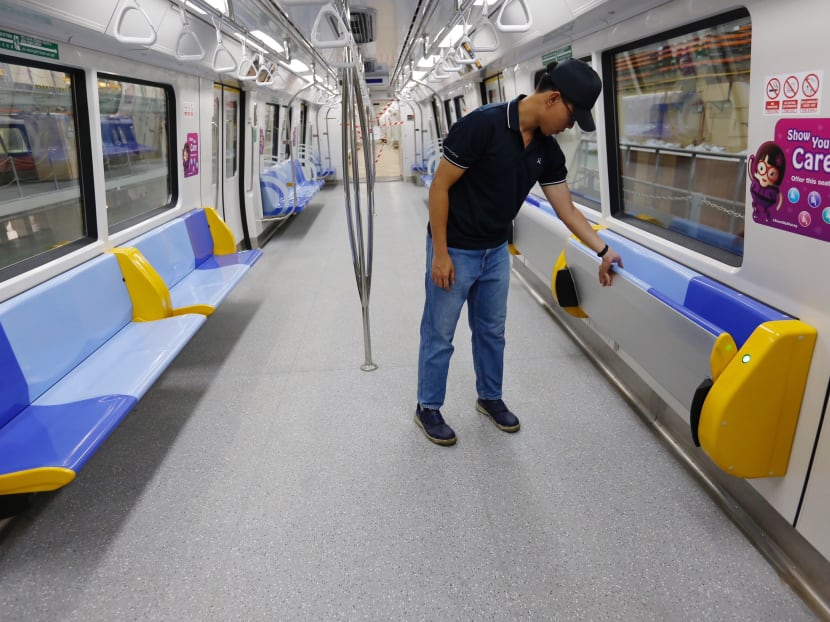New MRT trains to sport ‘tip-up’ seats for more standing room
SINGAPORE — Two new trains sporting foldable “tip-up” seats that can help to accommodate more commuters and ease the peak-hour crunch are set to go into operation in the second half of this year on the North-South and East-West Lines (NSEWL).

The trains feature new livery and tip-up seats, which can be folded up or down to allow for more standing space on trains. Photo: Raj Nadarajan/TODAY
SINGAPORE — Two new trains sporting foldable “tip-up” seats that can help to accommodate more commuters and ease the peak-hour crunch are set to go into operation in the second half of this year on the North-South and East-West Lines (NSEWL).
Each train can accommodate up to 100 more commuters with the seats folded, the Land Transport Authority (LTA) said on Wednesday (Feb 28).
A total of 12 new trains will have the foldable seats, though the other 10 are expected to arrive in Singapore only later this year and go into service next year.
It is unclear if the new feature will be introduced throughout the entire rail network. Foldable seats are already a fixture on trains in cities like New York and Paris.
For a start, LTA said the foldable seats will be operated by the train captains, who will decide whether to keep the seats up or down during their pre-service inspection checks.
“Further discussion on the operation of the seats will be conducted, but as a general guideline, the seats will be folded during peak hours,” said LTA’s director of rolling stock and depot engineering Chia Choon Poh.
Photos and a video of the new seats generated some debate among netizens after they were posted online by TODAY, with several questioning whether the drivers or commuters were better placed to decide when the seats ought to be folded.
“If commuters get to choose, it defeats the purpose because they will always choose to sit. The operator will be able to better gauge whether there needs to be extra space in the carriage,” said Ms Olivia Ng, a content strategist, 26.
“However, I am not sure whether this will be helpful for the elderly, because they will not have a seat when the seats are folded up,” she added.
Others questioned whether the foldable seats would significantly improve peak capacity, especially if the network was hit by faults or train delays.
Netizen Deborah Tan commented: “What’s the point of these foldable seats? Is it worth the trouble or the cost?”
Added Ms Ng: “Ultimately, I feel that the main reason for overcrowding on trains is due to the frequency and reliability of trains, not so much the additional standing space. If there is a delay, the next train will almost always be too crowded to board.”
Aside from the new seats, the 12 new trains made by Japanese-Chinese consortium Kawasaki-Sifang will be the first to bear the LTA’s red and green livery.
LTA’s logo will also be featured on the trains for the first time, reflecting the the move of all rail assets from rail operator SMRT to the Government under the New Rail Financing Framework.
The new trains also boast of a new safety feature - an improved Current Collector Device (CCD).
The CCD shoes are in contact with the third rail, which supplies electrical power to the train. In the event when the shoes are dislodged, a wire connection is broken, sending an automatic alert to train captains and operators that maintenance works may need to be carried out.
In the past, manual inspection was required when checking for missing or dislodged shoes.
The 12 new trains are the final batch of 57 new trains that are being put into service progressively on the NSEWL, Singapore’s oldest and most heavily-used MRT line.
The new additions will bring the existing NSEWL fleet to 198 trains, three times its starting size. The NSEWL’s original fleet of 66 trains will be retired progressively after 2022, said the LTA.
The inaugural fleet was also supplied by Kawasaki-Sifang, which was mired in controversy in 2016 when some of its trains were found to have hairline cracks, causing SMRT to withdraw some carriages from service. However, the Transport Ministry had said then that the cracks did not pose a safety risk.
In addition to the 57 new NSWEL trains, 24 new Circle Line trains and 18 new North-East Line trains have also been put in passenger service since 2015. This brings the total number of new trains for NSWEL, CCL and NEL to 99, at a cost of about S$1.1 billion.






